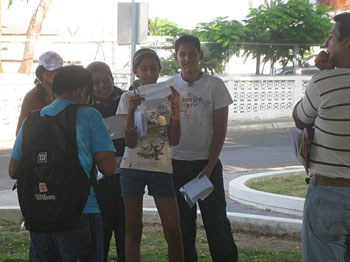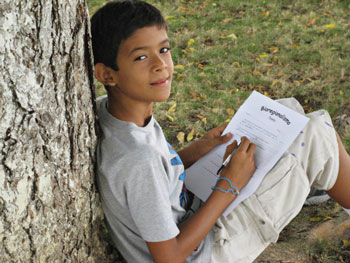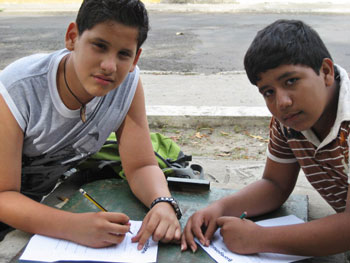Planet Drum Foundation
Bioregional Education Program
Report #1, May 2011 – English
(Click here for Spanish/Español)
Teacher: David Mera Villareal
In the following report I, Professor David Mera Villareal, will explain the work that I have done with the Ninth Year students of the Nation High School ‘Fanny de Baird’ during the month of May.
In the first week we covered the basics of Bioregionalismo. We learned about the characteristics of a bioregion. The students became familiar with the materials and then shared their ideas and comments. On Friday we had the opportunity to observe all of the Bahía bioregion from above during the field trip that we took to the Cruz (Cross) hilltop look out.

watches over his students as they present what they’ve been learning. Photo by
Clay Plager-Unger.
The second week we analyzed an article by Peter Berg, Planet Drum founder, where he explains the catastrophic environmental effects caused by human activity and the importance of raising peoples awareness in order to be able to stop and reverse this destructive process. We also learned about the environmental projects which are taking place in and around Bahía. The children drew a bioregional map of Bahía and a map of each of their neighborhoods. The children are very active in their participation and I am satisfied with their behavior. On Friday, we hiked to the overview in the Bellavista barrio[neighborhood]. From there we could see the ocean, Bahia, estuary, and surrounding forest; all of the ecosystems which form the Bahia bioregion.
The third week was successful due to the participation and work of the students. They studied the ‘steps to protect our bioregion.’ They organized themselves in groups to consider and answer questions relating to the necessities of life such as water, energy, waste, and culture. Afterwards, each group presented their work to the entire class. That Friday we took a field trip to the ‘Forest Amidst the Ruins.’ The children were very happy to explore the park. They listened to a presentation by Ramon about the history of the park and even planted some Guachepeli trees. We were accompanied by volunteers from Planet Drum and the Peace Corps.
During the fourth week, I gave the students an exam about Bioregionalismo and I was satisfied with their answers. They were able to demonstrate all that they had learned during the first month.


That Friday we took a field trip to the Bellaca beach. We started walking from the park in Leonidas Plaza and hiked over a big hill to the ocean. Once there the children bathed in the water.
I am participating in this project for the first time this year, but I am sure that we have reached the goals that were set for our class during the first month.
Sincerely,
David Mera Villareal
Fundación Planet Drum
Bioregionalismo
May 2011 – Spanish/Español
Profesor: David Mera Villareal
Mediante el presente hago conocer a ustedes, que los estudiantes del Noveno Año de Educación Básica del Colegio Nacional Fanny de Baird, junto con mi persona Profesor David Mera Villareal, hemos trabajado durante el mes de mayo del presente sin inconveniente alguna.
En la primera semana se trató el tema de Bioregionalismo. Aprendimos sobre las características de una bioregión. Los estudiantes adquirieron los conocimientos y luego participaron con ideas y criterios propios. El viernes tuvimos la oportunidad de observar toda la bioregión de Bahía durante el recorrido que se organizó al Mirador la Cruz.
La segunda semana se analizó un artículo de Peter Berg, fundador de Planet Drum donde explica sobre los efectos catastróficos causados por actividades humanas en el planeta y la concienciación de las personas para parar y revertir este proceso destructivo. También se analizó los proyectos ambientales en torno de la eco-ciudad. Los estudiantes dibujaron un mapa bioregional de Bahía de Caráquez y un mapa de la comunidad en el que habita cada alumno. La participación de los estudiantes fue activa y muy satisfactoria. Después, hicimos el recorrido al Mirador de Bellavista incrementando nuestros conocimientos de la educación ambiental.
La tercera semana fue exitosa en cuanto a la participación y trabajo en grupo de los alumnos. Ellos estudiaron los pasos para proteger nuestra bioregión. Los alumnos se organizaron en grupos para analizar y contestar preguntas relacionadas a las necesidades de la vida como: alimentos, agua, energía, basura, cultura. Luego cada grupo presentó su trabajo a toda la clase. El viernes se realizó el recorrido por el Bosque en Medio de las Ruinas (María Auxiliadora). Los niños y jóvenes estuvieron muy contentos y felices al encontrarse con la naturaleza. Sembraron árboles de guachapelí y escucharon la charla sobre la historia del Bosque en Medio de las Ruinas que les dictó Ramón. Además estuvieron acompañados por voluntarios del cuerpo de paz y Planet Drum.
En la cuarta semana se tomó la evaluación sobre bioregionalismo a los alumnos. Ellos respondieron las preguntas de manera satisfactoria y demostraron lo aprendido en el primer mes de clase. El viernes, hicimos el recorrido hacia la playa Punta Bellaca. Fuimos caminando desde el Parque Leonidas Plaza, hasta dicha playa, los alumnos se divirtieron y disfrutaron de un baño en el mar.
Yo, David Mera, en este año recién me inicio en este proyecto, y estoy seguro que hemos alcanzado el objetivo que nos hemos propuesto para el primer mes. Es todo cuanto puedo informar, para los fines pertinentes.
Atentamente
Lcdo. David Mera Villareal

Reader Interactions